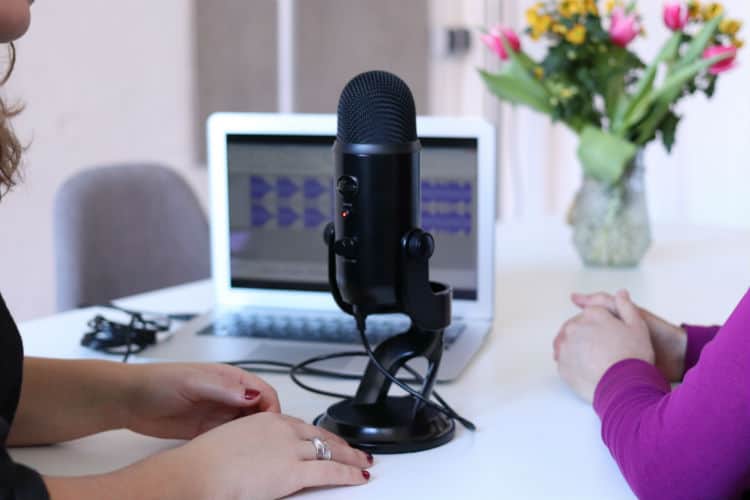Estimate reading time:
Answering the question, what is the best microphone for podcast, we must consider budget, recording style and ease of use. The best microphones do not have to cost an arm and a leg. Furthermore, today's podcasters have an array of inexpensive microphone that deliver studio recording quality. Here's a brief article that explains why the Yeti Nano from Blue Microphones is the preferred microphone for podcasts, voice-overs and YouTube content creators.
What's the best microphone for a podcast?
The best microphone for podcast is the Yeti Nano by Blue Microphones. It is a popular microphone that is used by YouTubers and podcasters. The Yeti sits comfortably on top of your desk and is a USB microphone. It is affordable and doesn't require additional equipment such as an audio interface. For this reason, many content creators and voice-over artists rely on this inexpensive and highly versatile microphone.
What Microphone Do Podcasts Use?
If you’ve ever asked yourself what microphone is best for podcast, the answer depends on what you’ll be using it for. Podcasters use a variety of microphones to suit their needs. There are currently a wide array of microphones on the market, all of which offer different features and specialties at competitive prices. Moreover, inexpensive podcast microphones offer near-studio quality and are compatible with devices such as desktop computers, laptops and tablets such as the ipad. In this article we discuss the Blue Yeti, a staple among YouTubers, podcasters and voice overs.
Here's more information on How To Record Voice Overs
Do You Need a Microphone to Record a Podcast?
Technically a podcast is simply an audio file that is available on the internet for streaming or download. For instance, most smartphones equipped with a microphone can do the job, however these devices are limited in dynamic range. For a more professional sounding recording, it is strongly recommended to use a microphone. Not only are they stable and tend to stay in one location therefore reducing the sound of bumps and external noises, they offer polar patterns that accommodate your recording style. For instance, polar patterns dictate where the microphone picks up it’s signal. Meaning that a omnidirectional polar patterns mostly pick up sounds in and around a room. Conversely, when set to a cardioid polar pattern, only sounds emitted from the from are recorded as opposed to sounds coming from the rear.
How Many Microphones Do You Need for a Podcast?

If you are recording a podcast that does not include other guest, then you only require a single microphone. An additional microphone is preferred in the event guests are present during your podcast. The Blue Yeti comes with four polar patterns, two of which are suitable for interview style podcasts. Remember that positioning is everything so be sure to sit in front of your Yeti while your guest faces the rear. Also, set the polar pattern to bidirectional so it picks up you and your guest.
What is a Good Quality Microphone?
There are several good quality microphones on the market. The good news is that you don’t need to spend a ton of money. USB microphones are popular and only require a computer and laptop to use. Furthermore, USB mics like the Blue Yeti don’t require additional equipment such as an audio interface and XLR cables, gear that are oftentimes cumbersome for smaller work spaces.
Yeti Nano Blue Microphones Features
Condenser microphone
Condenser microphones are commonly found in professional recording studios. They are durable and are capable of capturing sound pressure levels accurately. Additionally, capacitator microphones as they are commonly known as in Britain, use phantom power. The incoming signal is so fragile that additional power known as phantom power is used to boost the signal. What's great about the Yeti is that is has built in phantom power so no additional gear is necessary.
Four polar patterns

Polar patterns determine how a microphone interprets sound. For instance, the Yeti has four polar patterns that is adjustable through the multiple pattern selection knob.
- Omnidirectional
- Cardioid
- Bidirectional
- Stereo
Omnidirectional: When set to this position, the Yeti will pick up all sound in a room. Used if you're in a relatively quiet space with several speakers but only have access to a single microphone. This setting will capture all speech but beware of of using this mode in reverberating spaces. Upon playback, indiscernible audio and drowned out speech might occur.
Cardioid: Use this setting to record your voice. When set to cardioid mode, the Yeti captures sounds coming from the front of it while rejecting sounds coming from its side and rear.
Bidirectional: Plan on interviewing a guest on your podcast? Then choose the bidirectional setting on the Yeti mic. This setup causes the Yeti to focus on signals in front and in back of it's capsule.
Stereo: The stereo mode use both the right and left channels and thus captures a wider stereo field. Ideal for instruments such as pianos and acoustic guitars.
Shockmount Option

Optionally, the Yeti provides a versatile alternative for those with limited deskspace. The Yeticaster arm and shock mount not only helps to reduce low end rumbling caused by bumping your hands on the desk, it also the mic to be positioned directly in front of your mouth. The same can be said for instruments. As a result, sounds that mic'ed in close promity to the mic's capsule sound clearer and discernible.
Gain Control
You can adjust the amount of volume that enter the capsule (head of microphone). For best results speak clearly into the mic and avoid turning up the gain knob excessively.
Mute button
Ideal for necessary pauses or interruptions such as phone calls or excessive temporary ambient noises (passing fire truck sirens etc.)
Headphone Output
Monitor what you're recording.
Unique positionable design
The Yeti microphone comes with an adjustable tilt hinge so the microphone capsule faces your mouth or instrument. For clearer speech, always be sure to point the capsule towards the signal source.
USB Microphone
The Yeti is a USB microphone and doesn't plug into an audio interface. For this reason, it is plug and play and is perfect for vocals, musical instruments, podcasting, voice overs, interviews, gaming, field recordings, conference calls and more
System requirements
Windows
Windows 7, 8.1, or 10
USB 1.1/2.0/3.0
MACINTOSH
macOS 10.10 or higher
USB 1.1/2.0/3.0
3 Types of Yeti Microphones
Yeti
Yeti Studio
Yeti Pro (XLR compatible and audio software)



